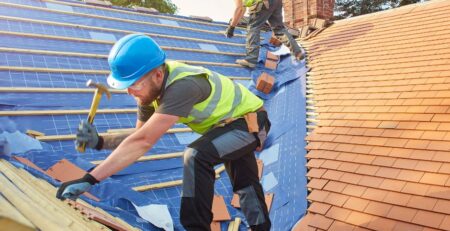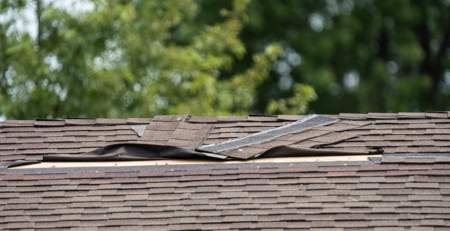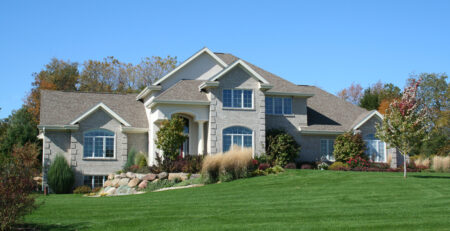How Long Do Flat Roofs Last?
Flat roofs typically last between 10 to 30 years. The durability is influenced by correct installation, high-quality materials like EPDM rubber or TPO membranes, and regular maintenance. Environmental conditions, drainage systems, and insulation also impact the lifespan. Various flat roofing materials like Built-Up Roofing, EPDM rubber, TPO membranes, PVC, and Modified Bitumen offer different levels of protection. Signs of damage to watch for include ponding water, blistering, cracks, and wear.
Implementing a proactive maintenance plan with our expert roof technicians and early issue resolution can help significantly extend a flat roof’s life.
Factors Affecting Flat Roof Lifespan
Various factors greatly influence the lifespan of flat roofs, affecting their durability and performance over time. One crucial element is proper installation. A flat roof must be installed correctly, with adequate sealing or flashing, and is prone to leaks and structural damage. Moreover, the quality of materials used plays a significant role. High-quality roofing materials, such as EPDM rubber or TPO membranes, can better withstand harsh weather conditions and UV exposure, prolonging the roof’s lifespan.
Regular maintenance is another crucial factor in extending the life of a flat roof. Inspections should be conducted at least twice a year to promptly identify and address any issues. Poor maintenance can lead to minor problems escalating into significant repairs, shortening the roof’s lifespan. Climate and environmental factors, such as heavy rainfall, snow, or extreme temperatures, also impact flat roofs. Proper drainage systems and insulation can help mitigate the effects of these factors, ensuring the roof lasts longer. By considering these factors, property owners can improve the longevity of their flat roofs.
Common Types of Flat Roofing Materials
Proper selection of roofing materials is paramount in ensuring the longevity and performance of flat roofs. Several common types of flat roofing materials are used in the construction industry. One prevalent option is built-up roofing (BUR), consisting of multiple bitumen layers alternated with reinforcing fabrics. BUR provides excellent waterproofing and UV protection.
Another popular choice is Ethylene Propylene Diene Monomer (EPDM) rubber roofing, which is durable, cost-effective, and easy to install. Thermoplastic Polyolefin (TPO) roofing membranes are also commonly used due to their energy efficiency and resistance to ultraviolet light and chemical exposure. Polyvinyl chloride (PVC) roofing offers benefits similar to TPO but is generally more expensive.
Moreover, Modified Bitumen Roofing, a hybrid of BUR and a polymer-modified material combines the benefits of both systems. Each type of roofing material has its unique characteristics, advantages, and considerations, so selecting the most suitable option depends on factors such as climate, budget, and intended lifespan.
Signs of Flat Roof Damage
Detecting signs of flat roof damage early is essential in preventing costly repairs and ensuring the structural integrity of the building. One common indication of flat roof damage is ponding water, which accumulates in low-lying areas due to poor drainage. If not addressed promptly, this can lead to leaks, deterioration of the roofing material, and structural issues. Another sign to watch for is blistering or bubbling on the roof surface, often caused by trapped moisture or improper installation.
Moreover, cracks in the roofing material or seams can also signify damage that needs attention. These openings allow water to seep into the roof layers, causing further deterioration. In addition, if you notice extensive wear and tear, such as exposed or missing roofing materials, it indicates that the roof needs repair or replacement. Regular inspections by a professional can help identify these signs early and prevent extensive damage to the flat roof.
Tips for Extending Flat Roof Life
Diligent maintenance practices and proactive measures are essential to maximizing the longevity of a flat roof. Regular inspections to detect and address issues promptly can prevent minor problems from escalating into significant damage.
Clearing debris, ensuring proper drainage, and swiftly repairing any leaks are fundamental maintenance tasks that can significantly extend the life of a flat roof. Moreover, scheduling annual professional inspections can help identify potential problems early on and allow for timely interventions. Implementing a preventative maintenance plan that includes regular cleaning, inspections, and repairs can help avoid costly replacements and prolong the lifespan of the flat roof.
In addition, considering factors such as weather conditions, foot traffic, and the presence of nearby trees can also help tailor maintenance efforts to suit the specific needs of the flat roof, ultimately contributing to its longevity. Property owners can maximize the durability and lifespan of their flat roofs by investing time and resources into proactive maintenance practices.









